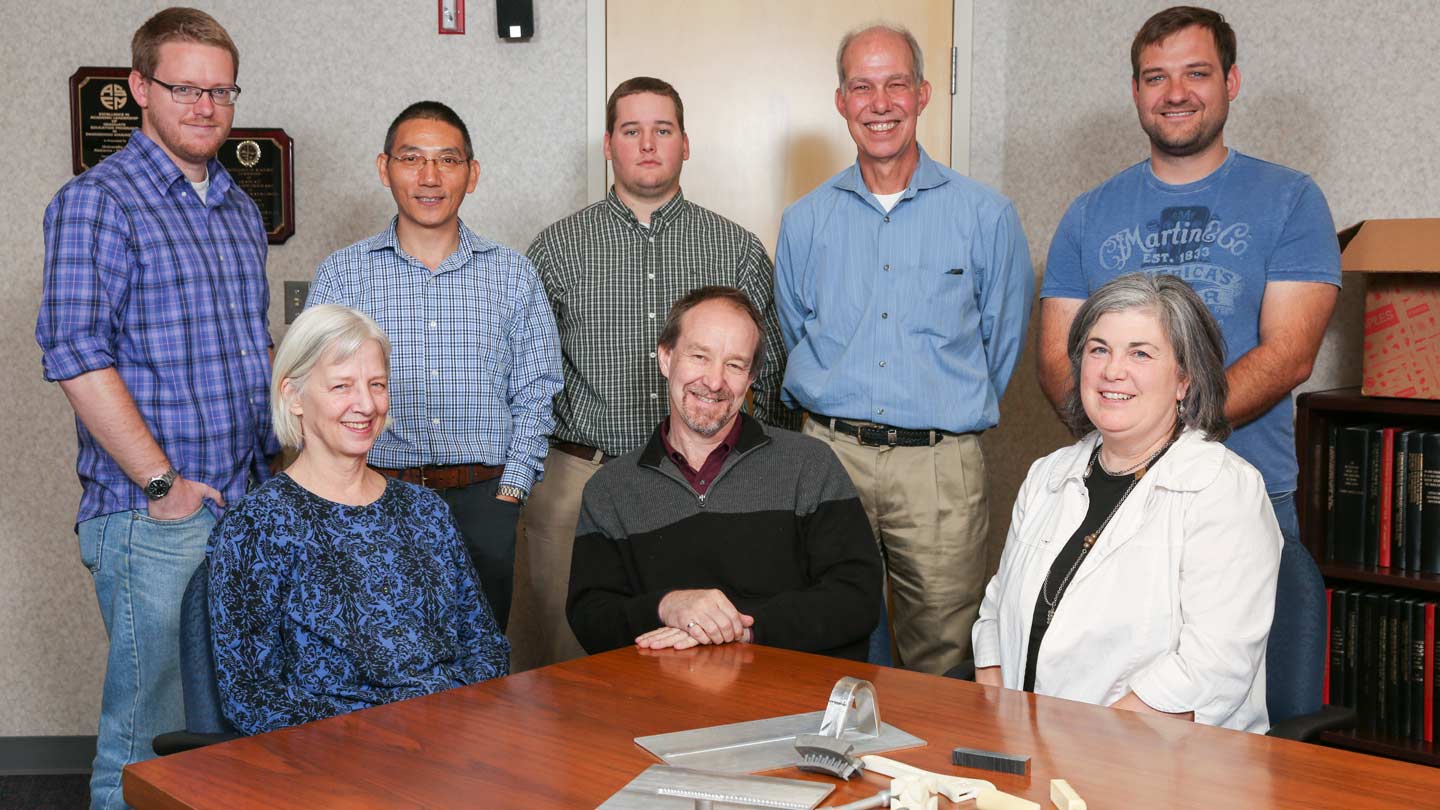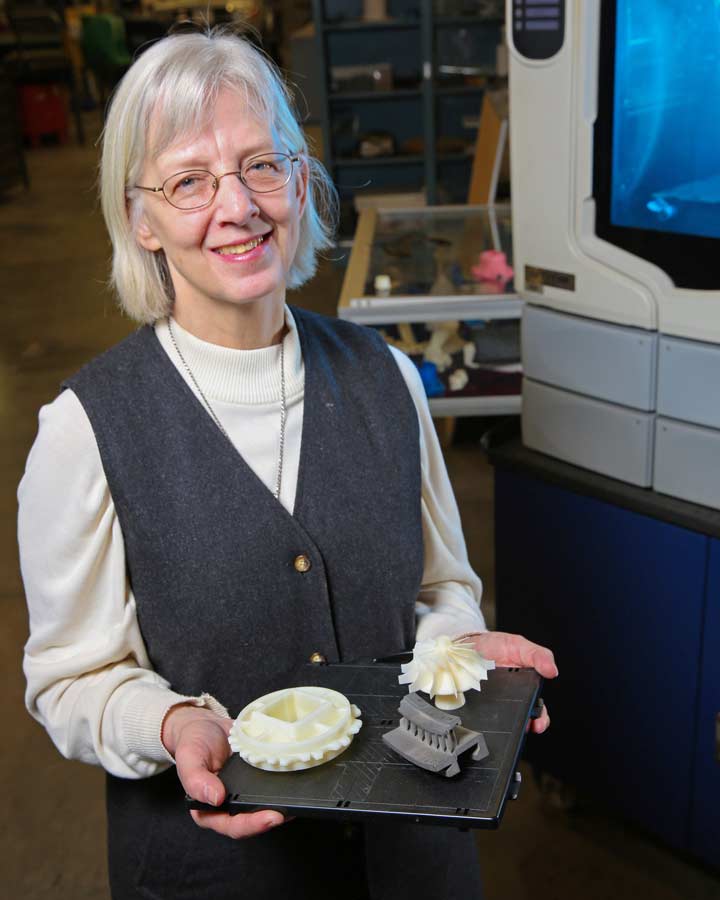
UAH additive manufacturing researchers, from left: Front – Judy Schneider, mechanical and aerospace engineering (MAE); Phil Farrington, industrial & systems engineering and engineering management (ISEEM); Sherri Messimer, ISEEM. Back – Tom Stockan, MAE; Ken Zwo, MAE; Ben Beeker, MAE; Mike Banish, chemical and materials engineering; Justin Sweitzer, MAE.
Michael Mercier | UAH
The many advantages of additive manufacturing, including cost control and precision, are pushing the adoption of the technique in plastics and metals in
the automotive and manufacturing industry, as well as at NASA and in the U.S. military.
It's one thing to be able to print parts that were formerly cast and machined, but it's another to say that you have confidence in the reliability of those
printed parts. To do that, you must have a high degree of confidence in the raw materials being used, in the formulas involved in their combination if more
than one material is used, and in your understanding of the microstructures being formed in the finished product, as well as in the processes and systems
used during manufacturing.
Scientists and engineers at The University of Alabama in Huntsville (UAH) are exploring all these areas in the rapidly evolving field.
Additive manufacturing is being fueled by the advances in computers and computational abilities and the advent of new alloys that can be combined in new ways. The promise of additive manufacturing is that you’re no longer confined to a monolithic material with monolithic properties, so now you can design structures with varying properties.
"Now, it's all about using these processes to create new structures with unique properties in a greatly compressed timeframe, but the quality control
people are saying, 'Wait a minute, will it last?'" according to Dr. Judith Schneider, a professor of mechanical engineering who works with manufacturers
and the government to research the effect of temperature and strain on the microstructures of metals used in additive manufacturing printing.
That's something she says is crucial to ensuring that printed parts can be made with a high degree of predictability about their underlying microstructure
and longevity.
"Additive manufacturing is being fueled by the advances in computers and computational abilities and the advent of new alloys that can be combined in new
ways," she says. "The promise of additive manufacturing is that you're no longer confined to a monolithic material with monolithic properties, so now you
can design structures with varying properties."
Currently, additive manufacturing is following a two-track course similar to one Dr. Schneider says she experienced when NASA implemented the relatively
new friction stir welding process in 1995. Because that process was superior, it began being used almost immediately while at the same time the
fundamentals of what was occurring in the process were being studied. As that knowledge increased, so did confidence in the products of the process.
"With additive manufacturing, we are now in the process of establishing the guidelines and the practices to increase our confidence," she says. "We don't
understand yet the cause and effect of the variables of the materials and the manufacturing processes. We're just in the infancy of knowing what the flaws
are, and as we get new and different materials, there are going to be additional problems to study."

Dr. Judith Schneider’s additive manufacturing research involves ensuring that printed parts can be made with a high degree of predictability about their inner structure and longevity.
Michael Mercier | UAH
New applications ranging from printing spare parts for spacecraft in space to printing battlefield replacement parts for soldiers seem to be on the
horizon, yet the promise of additive manufacturing is tempered by the field's infancy.
Cast and machined parts have the benefit of hundreds or even thousands of years of accumulated knowledge, providing a high degree of confidence in their
performance. The additive manufacturing of metals is a completely different technology that results from metal being instantaneously cooled in a process
that Dr. Schneider says is similar to "splat cooling." That rapid cooling creates much different microstructures in metal parts than in conventional cast
or machined parts. The structures formed and strains placed in the microstructures of printed metals are not yet well understood.
"If we can understand fundamentally how these materials behave in an additive manufacturing environment, then we won't have to test those materials
anymore," she says. "I look at how materials behave in extreme conditions." Her past research has examined material responses to cryogenic temperatures and
also high-strain rate conditions.
Bimetallic printing - the ability to co-print disparate metals in a single part - is seen as one of the great potentials for additive manufacturing, and
Dr. Schneider is exploring the nature of the microstructural bonds between various metals to unlock fundamental understanding of the interaction of these
materials and how they best can be combined in the printing process to form a strong bond.
"We're not there yet, but that's the promise," she says of bimetallic printing. "That's the holy grail of additive manufacturing."
Collaborative bonds
Dr. Phillip Farrington, professor of industrial and systems engineering, reaches out to defense, industry, private foundations and professors in other
disciplines on the UAH campus in a quest to understand and perfect bimetallic additive manufacturing, a process that could save myriad machining steps if
perfected.
"The primary question we are trying to address is, can we bond dissimilar materials together using additive manufacturing technologies," says Dr.
Farrington. "There has been some limited success bonding copper and Inconel, so we hope to build on that earlier work to advance our research."
Some additive manufacturing technologies, such as Laser Engineered Net Shaping (LENS) or welding-based additive manufacturing processes, present the
possibility of creating bi-metallic parts in one or possibly two steps, an achievement Dr. Farrington says could substantially reduce production time and
costs.
"Both NASA and the U.S. Army are interested in this type of application because they have systems that would benefit from the ability to create bi-metallic
joints," he says.
A multidisciplinary UAH Additive Manufacturing Research Team has received a grant from the Presto Foundation to study the use of additive manufacturing
technologies in the development of Dept. of Defense systems.
"When the opportunity to submit this proposal to the Presto Foundation came about, Dr. Messimer and I discussed other faculty who had the background to
support the research, and as a result Dr. R. Michael Banish, an associate professor from the Department of Chemical and Materials Engineering, and Dr.
Qiuhai "Ken" Zuo, an associate professor from the Department of Mechanical and Aerospace Engineering, joined the team," says Dr. Farrington.
"Dr. Messimer developed and teaches a course on additive manufacturing for the Industrial & Systems Engineering and Engineering Management Department
(ISEEM)," he says. "Dr. Schneider was invited to join the team as soon as we got word she was coming to UAH because of her extensive work on additive
manufacturing, and she joined in fall 2015 when she came to UAH."
The team knew that the U.S. Army Aviation and Missile Research, Development and Engineering Center (AMRDEC) and Marshall Space Flight Center (MSFC) were
both using additive manufacturing technologies.
"We invited them to help us refine the question we were addressing, and they both indicated interest in using additive manufacturing technologies to
produce bi-metallic joints," Dr. Farrington says. "Also, MSFC has provided material to an additive manufacturing equipment manufacturer that has agreed to
produce test articles for our study, at no cost to UAH."
That alliance has allowed the UAH team to expand and augment its base study.
"Beyond advancing the use of additive manufacturing for creating bi-metallic joints, my personal goal for this project is to enhance further collaboration
on additive manufacturing research between UAH, MSFC and AMRDEC," says Dr. Farrington.
There could be wide-ranging impacts. Additive manufacturing processes are a key research focus of the Southern Alliance for Advanced Vehicle (SAAV)
Manufacturing Center, which promotes greater research and development ties between vehicle manufacturers and its academic partners. SAAV began in 2014 a
partnership between UAH, Auburn University and Tennessee Technological University and was funded by a National Science Foundation grant.
"We have potential member organizations interested in joining the center who are interested in this research," Dr. Farrington says.
Systemic approach
Dr. Paul Collopy, ISEEM's chair, looks at the field with a systems engineering approach.
"What I'm looking at is how the additive manufacturing process fits the bigger picture, as far as making rockets and jet engines and more complicated
systems like that," says Dr. Collopy, who formerly worked for the National Science Foundation as director for the Engineering Systems Design and Systems
Science programs.
"The fastest growing modern firms, like Google, Cisco and Twitter, all have a core competence of developing systems out of software," he says.
"In software development, you can try daring things, and if they don't work, you say, 'Well, I lost a day.' The neat thing about additive manufacturing is,
you can experiment on a similar cycle: think up a daring design, push a button and you get your part out so you can test it."
Additive manufacturing has the ability to take months and even years off the time between design and physical part testing, and Dr. Collopy says that is
liberating for engineers working with complex cutting-edge technologies.
Build and break testing is immediately rewarding, he says.
"We love the idea of testing in software simulation, but every real engineer who is working with a complex system or a complicated problem, they want to
get hardware and break it," says Dr. Collopy. "Then you really know the design's abilities, its durability and its capabilities."

Dr. Paul Collopy, chair of UAH’s Industrial & Systems Engineering and Engineering Management Department.
"When you are engineering technically challenging hardware, you really want to get to hardware fast," Dr. Collopy says, and that's where the materials,
structural and process knowledge all come together in a systems engineering approach. "However, building things fast really doesn't work if what you build
is not quality, and that is the current research frontier in additive manufacturing."
Rapid production capability for numerous variations on a design removes limits to engineering that are present because of subtractive manufacturing
processes previously used. In subtractive manufacturing, raw materials are shaped and removed rather than added and formed to achieve a product.
"What you design is shaped by your manufacturing processes," says Dr. Collopy. "Additive manufacturing is a completely different process that allows you to
do things you couldn't do before."
He points to work by Jonathan E. Jones with NASA's NanoLaunch effort at MSFC, which is using additive manufacturing to create scaled test vehicles that
have the potential to propel programs across the "valley of death" between laboratory demonstrations and actual in-flight environments.
"He's trying to explore a completely different way of making rockets," Dr. Collopy says. "He doesn't have to wait around on a lengthy procurement process.
He can go right down to the NASA Marshall Space Flight Center 3-D printing shop and print what he needs in an afternoon. If you go over to NASA to look at
what they've got, they've got a room full of 3-D printing machines on a large scale."
Speaking of scale, Dr. Collopy notes that ISEEM's Dr. Messimer has studied larger-scale additive manufacturing at Penn State, the home of a facility full
of additive manufacturing machinery "that is very nearly on a large manufacturing level."
And in a new twist at UAH's Manned/Unmanned Collaborative Systems Integration Laboratory in Olin B. King Technology Hall - a collaboration with the U.S.
Army's Research, Development and Engineering Command (RDECOM) at the U.S. Army Research Laboratory - students working with autonomous systems in a gaming
environment now have access to a 3-D printer, as well.
"This takes it out of the software-only design and testing setting into a new area," Dr. Collopy says. "Our vision is that a student designs an autonomous
tracked vehicle in simulation using the software and then can 3-D print the structure for it right there. We then add the electronics, motors and other
hardware to that to get a working model. It adds a new dimension to what they are doing."
Additive manufacturing is experiencing exponential growth that is in its own way additive, Dr. Collopy says, though he notes that the human mind favors
identifying linear growth but has difficulty perceiving the exponential kind. Exponential growth builds on prior pillars of knowledge and experience, so
that initially the curve may look flat but then it takes a sudden upward turn that is very similar to the shape of an ocean wave. UAH is riding that swell.
"For example, for additive manufacturing to grow, you have to have people experienced in additive manufacturing," Dr. Collopy says. "But you can't get
those and you can't get that experience until you have scaled up to the kinds of larger manufacturing environments that can provide them. Once those are in
place, things can move quickly. That's just one example of how things must grow exponentially, building on what we have and what we learn."
Some projections show that a matured additive manufacturing field may still only account for 2 percent of all parts made, Dr. Collopy says, but if most of
those parts are made to telescope development times, that will free engineers to cheaply test a myriad of approaches to any one problem rather than
singling out only a few possible solutions due to time and cost constraints.
"For testing purposes, it's going to change how we make complex systems."